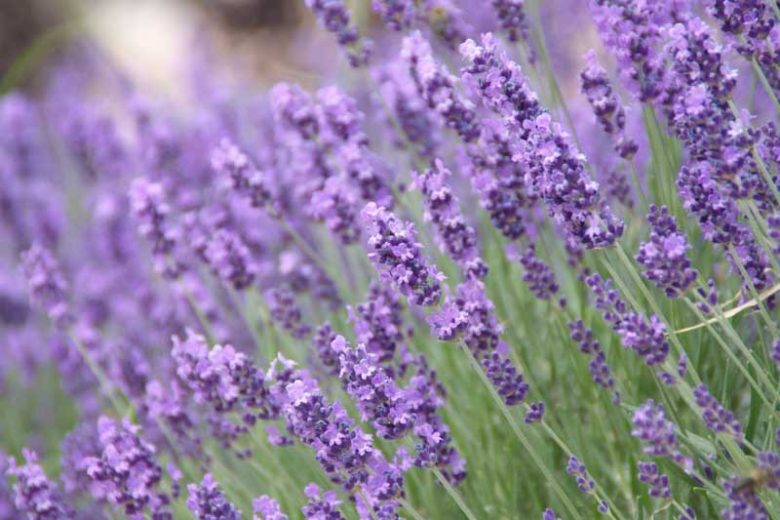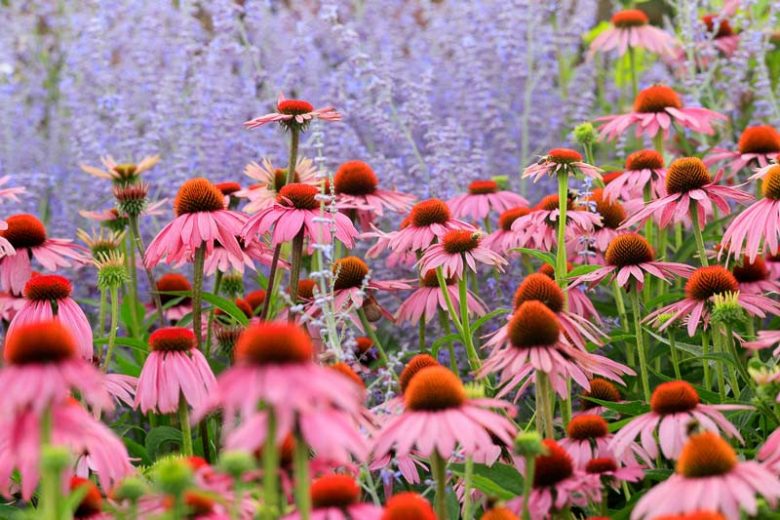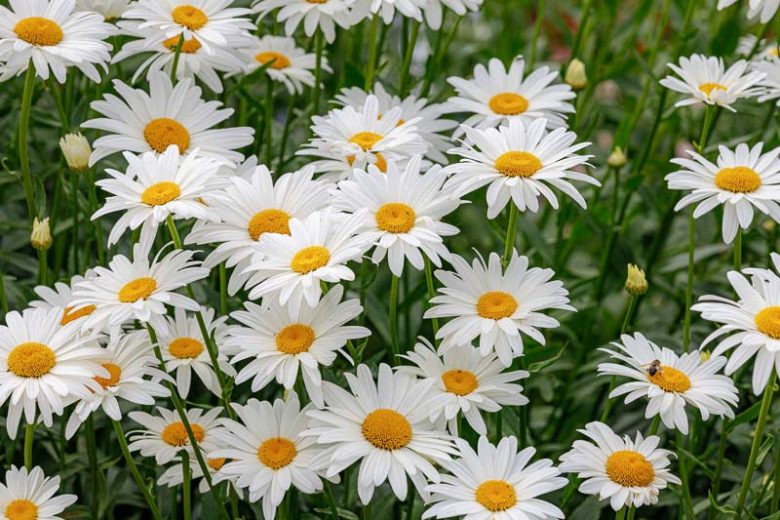Perennials are the perfect choice for any garden enthusiast looking for long-lasting beauty and minimal maintenance. When selecting plants, choosing perennials that thrive in full sun is essential to ensure vibrant blooms and healthy growth throughout the year. Full sun perennials can create stunning flower displays and attract beneficial pollinators, all while enhancing your garden’s aesthetic appeal.
In this article, we explore 13+ full sun perennials that will flourish in sunny garden spots. Whether you’re looking to beautify your backyard, create a colorful border, or attract bees and butterflies, these plants will offer year-round enjoyment.
1. Black-eyed Susan (Rudbeckia hirta)

Black-eyed Susan is a native American plant that thrives in full sun and blooms from mid-summer to fall. The plant’s bright yellow petals and dark brown center make it an eye-catching addition to any garden. Black-eyed Susan is incredibly easy to grow, adapting well to various soil types and conditions.
This perennial prefers well-drained soil but is forgiving if the soil becomes dry. Once established, it requires little water, making it perfect for low-maintenance gardens. The plant’s vibrant yellow flowers will draw pollinators like bees and butterflies, adding a lively element to your garden. Black-eyed Susan also tolerates drought conditions, which makes it a great choice for regions with hot summers or areas where water conservation is essential.
These flowers can grow up to 3 feet tall, making them ideal for the back of flower beds or as a cut flower for fresh arrangements. For a more natural look, plant them in groups for a stunning display of yellow blooms.
2. Lavender (Lavandula angustifolia)

Lavender is a fragrant, versatile perennial that thrives in full sun. Known for its lovely purple flowers and soothing scent, it is a great choice for adding both beauty and aroma to your garden. Lavender is drought-tolerant and thrives in well-drained, slightly alkaline soil. It prefers dry conditions, making it a perfect plant for gardeners who want a low-maintenance option that does not require constant watering.
Aside from being visually appealing, lavender is a favorite among pollinators like bees and butterflies. It also has numerous uses, from essential oils to culinary applications, adding an extra layer of value to your garden. Lavender can grow between 18 to 36 inches tall, depending on the variety, and it is often used in borders, rock gardens, or container gardening.
To maintain its shape and encourage new blooms, prune your lavender plants after they finish flowering. Lavender’s evergreen foliage provides year-round interest, even when the flowers are not in bloom.
3. Coneflower (Echinacea purpurea)

Coneflower is another stunning, sun-loving perennial that can easily withstand the heat and grow in a variety of soil types. It produces large, daisy-like flowers with a striking purple cone-shaped center that adds a pop of color to any garden. Coneflower’s long-lasting blooms make it a favorite among gardeners who enjoy vibrant, low-maintenance plants.
This perennial grows best in full sun but can tolerate light shade. Coneflowers are drought-resistant once established, making them a smart choice for water-wise gardens. They attract a variety of pollinators, including bees and butterflies, and the seed heads are a food source for birds in the fall and winter.
Coneflower typically grows between 2 to 4 feet tall, making it an excellent choice for the middle or back of garden beds. The plant’s sturdy stems and unique flower shape also make it ideal for use in cut flower arrangements. Deadheading the spent blooms will encourage additional flowering throughout the season.
4. Daylilies (Hemerocallis)

Daylilies are one of the most versatile and hardy full sun perennials. Known for their large, trumpet-shaped flowers that bloom in a rainbow of colors, daylilies are perfect for creating colorful displays in the garden. Each flower lasts for only a day, but with multiple blooms per stem, the plant provides long-lasting color throughout the summer.
Daylilies are extremely adaptable and can thrive in a wide range of soil types and conditions. They are also drought-tolerant and low-maintenance, making them a great option for busy gardeners. Daylilies bloom best when planted in full sun, although they can tolerate some light shade.
Daylilies typically grow between 18 to 36 inches tall and are suitable for use in borders, as ground cover, or even in containers. Their vibrant colors and ability to bloom in waves will keep your garden looking fresh and lively all season long.
5. Shasta Daisy (Leucanthemum x superbum)

The Shasta Daisy is a classic perennial that brings a fresh, cheerful look to any garden. With its white petals and yellow center, the Shasta Daisy is a symbol of purity and simplicity. This plant thrives in full sun and will reward you with a stunning display of flowers from late spring to early summer.
Shasta daisies are easy to grow and tolerate a wide range of soil types, as long as it is well-drained. They prefer slightly acidic to neutral soil but can adapt to most conditions. This perennial is also drought-tolerant once established, making it perfect for low-maintenance gardens.
Shasta daisies grow between 12 to 36 inches tall and work well as a cut flower or as part of a mixed border. They can be deadheaded to promote additional blooms, and the plant’s compact nature makes it suitable for smaller gardens or containers.
6. Russian Sage (Perovskia atriplicifolia)
Source
Russian Sage is a striking perennial with tall, airy spikes of lavender-blue flowers and aromatic, silver-gray foliage. This plant thrives in full sun and well-drained soil, making it a great option for hot and dry climates. Russian Sage has a unique, wispy appearance that adds texture and contrast to garden beds.
This perennial is incredibly hardy and drought-tolerant once established. It also attracts pollinators like bees and butterflies, making it an excellent choice for a wildlife-friendly garden. Russian Sage grows between 3 to 5 feet tall, making it an excellent addition to the back of the garden or as a backdrop for shorter plants.
Russian Sage’s silvery foliage provides visual interest even when the flowers are not in bloom, and it requires minimal maintenance. It can be pruned back in early spring to encourage fresh growth and ensure a neat appearance.
7. Coreopsis (Coreopsis verticillata)
Source
Coreopsis, commonly known as tickseed, is a bright and cheerful perennial that thrives in full sun. This plant produces daisy-like flowers in shades of yellow, pink, or red, which bloom profusely from early summer to fall. Coreopsis is well-known for its long blooming period and low-maintenance care.
It prefers well-drained, moderately fertile soil and is drought-tolerant once established. Coreopsis works well in both formal and informal gardens, making it a versatile choice for various garden styles. This plant attracts pollinators and is often used in wildflower gardens, cottage gardens, and pollinator-friendly landscapes.
Coreopsis grows between 12 to 18 inches tall, making it ideal for the front of flower beds or as a ground cover. It also works well in containers or hanging baskets, adding a burst of color to patios and porches.
8. Blanket Flower (Gaillardia)
Source
Blanket flowers, or Gaillardia, are vibrant and hardy perennials that thrive in full sun. Known for their bright, fiery red and yellow blooms, these plants are perfect for adding a bold splash of color to any garden. Blanket flowers bloom profusely throughout the summer and into fall, providing a long-lasting display of color.
This plant grows well in a variety of well-drained soils, including sandy and poor soils, making it ideal for gardeners looking for a hardy, low-maintenance option. Blanket flowers are also drought-tolerant once established, meaning they require minimal watering. They attract bees, butterflies, and other pollinators, adding life to your garden while contributing to local ecosystems.
Blanket flowers grow between 12 to 24 inches tall and are perfect for the front or middle of flower beds. They can also be used in container gardening for a burst of color on patios or balconies. Deadheading spent flowers encourages the plant to produce new blooms throughout the growing season.
9. Autumn Joy Sedum (Sedum ‘Autumn Joy’)
Source
Autumn Joy Sedum, also known as Hylotelephium, is a versatile perennial that thrives in full sun. This plant features thick, succulent leaves and large, rounded clusters of pink to red flowers that bloom late in the summer and into fall. As the flowers age, they deepen in color, creating a stunning contrast against the plant’s green foliage.
Sedum is highly adaptable and can grow in poor, well-drained soil. Once established, it is incredibly drought-tolerant, making it a perfect addition to xeriscapes or low-water gardens. Autumn Joy Sedum attracts bees and butterflies, making it an excellent choice for pollinator gardens.
This perennial grows between 18 to 24 inches tall and works well as a border plant, in rock gardens, or as part of a mixed flower bed. Its sturdy stems and unique blooms also make it a fantastic choice for cut flower arrangements. Autumn Joy Sedum requires little maintenance, and its winter interest makes it a great addition to your garden year-round.
10. Yarrow (Achillea millefolium)
Source
Yarrow is a tough, sun-loving perennial that produces clusters of flat-topped flowers in a variety of colors, including white, yellow, pink, and red. Known for its ability to tolerate poor soils and dry conditions, yarrow is the perfect plant for gardeners seeking a low-maintenance option that adds a pop of color to their landscape.
Yarrow thrives in full sun and well-drained soil, and once established, it is drought-tolerant. The plant’s feathery foliage provides texture and interest, while the flowers attract bees and butterflies. Yarrow is also known for its medicinal properties, as it has been used in traditional herbal remedies for centuries.
This perennial grows between 18 to 36 inches tall and is perfect for borders, cottage gardens, or wildflower meadows. Yarrow is also an excellent cut flower, making it ideal for fresh or dried arrangements. To keep the plant looking neat and to encourage more blooms, deadhead the spent flowers regularly.
11. Bee Balm (Monarda didyma)
Source
Bee Balm is a beautiful, aromatic perennial that thrives in full sun and attracts pollinators like bees, butterflies, and hummingbirds. Known for its vibrant, tubular flowers in shades of red, pink, and purple, Bee Balm adds a burst of color and fragrance to your garden. The plant’s distinctive, minty scent makes it a favorite for herb gardens and outdoor spaces.
Bee Balm grows best in moist, well-drained soil but is relatively adaptable and can tolerate various conditions. It is drought-tolerant once established but will thrive with regular watering. This perennial is also known for its ability to resist deer and rabbits, making it a great choice for gardens with wildlife issues.
Bee Balm typically grows between 2 to 4 feet tall, making it a perfect addition to the middle or back of flower beds. It works well in cottage gardens, herb gardens, or naturalized landscapes. Deadheading will encourage more blooms, and the plant’s aromatic foliage adds extra sensory appeal.
12. Penstemon (Penstemon digitalis)
Source
Penstemon, commonly known as beardtongue, is a showy, sun-loving perennial that produces spikes of tubular flowers in shades of purple, pink, and white. Known for its hardiness and vibrant color, Penstemon is a fantastic choice for gardeners looking to add height and visual interest to their flower beds.
Penstemon thrives in full sun and well-drained, slightly acidic soil. It is drought-tolerant once established, making it a great option for water-conscious gardeners. The flowers attract a variety of pollinators, including bees, hummingbirds, and butterflies, making it an excellent addition to any pollinator-friendly garden.
Penstemon typically grows between 18 to 36 inches tall and is ideal for the back of garden beds or as part of a mixed perennial border. Its striking flowers and upright habit make it a great focal point in the landscape. Deadheading the spent blooms will encourage a second round of flowering, prolonging the plant’s beauty throughout the season.
13. Coreopsis ‘Moonbeam’ (Coreopsis verticillata)
Source
Coreopsis ‘Moonbeam’ is a delicate, yet hardy perennial that produces soft, yellow, daisy-like flowers. It thrives in full sun and is perfect for creating a gentle, bright display in your garden. This variety of Coreopsis is known for its fine, thread-like foliage that gives it a soft, airy look.
Moonbeam Coreopsis grows well in well-drained soil and is drought-tolerant once established. It attracts a variety of pollinators, including bees and butterflies, and adds a light, airy feel to flower beds or borders. The plant blooms from late spring to summer and continues to flower with regular deadheading.
Coreopsis ‘Moonbeam’ grows between 12 to 18 inches tall, making it ideal for the front of flower beds, as ground cover, or in containers. It pairs well with other sun-loving perennials and provides year-round interest with its delicate foliage.
Conclusion
Choosing the right full sun perennials for your garden can elevate the overall look of your outdoor space while reducing maintenance. These 13+ plants are not only stunning and vibrant but also attract pollinators, making your garden an essential part of your local ecosystem. From the bold and cheerful Black-eyed Susan to the delicate beauty of Coreopsis ‘Moonbeam,’ each of these perennials offers something special for your garden.
Whether you are looking to create a colorful border, attract wildlife, or simply enjoy the beauty of nature, these sun-loving perennials are an excellent choice. Plant them in your garden, and you’ll enjoy their beauty and resilience year after year. Happy gardening!


